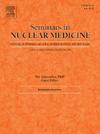胃泌素释放肽受体靶向PET成像在肿瘤诊断中的价值:系统综述。
IF 5.9
2区 医学
Q1 RADIOLOGY, NUCLEAR MEDICINE & MEDICAL IMAGING
引用次数: 0
摘要
胃泌素释放肽受体(GRPR)在多种癌症中过表达,是正电子发射断层扫描(PET)的一个有希望的靶点。本系统综述探讨了grpr靶向PET成像在肿瘤学中的诊断价值。到2024年5月23日,对主要医学数据库进行了系统搜索。修改关键词,纳入肿瘤患者grpr靶向PET的临床原始研究。在最初检索的1624项研究中,有107项符合全文综述的条件。总体而言,38项研究的数据符合纳入标准,研究了grpr靶向放射性示踪剂在乳腺癌、前列腺癌、胃肠道间质瘤(GIST)和胶质瘤(包括视神经通路胶质瘤和多形性胶质母细胞瘤)中的应用。在乳腺癌中,grpr靶向PET可有效检测原发肿瘤和转移灶,尤其是雌激素受体(ER)阳性患者,并预测治疗反应。在前列腺癌中,观察到检测原发性肿瘤的高灵敏度(高达88%)和特异性(高达90%),当与磁共振成像(MRI)结合使用时提供了附加价值。在生化复发中,即使PSA水平低于0.5ng/dL,也能确定前列腺癌的部位。与PSMA PET相比,grpr靶向PET的检出率相当或更高。考虑到GIST, grpr靶向PET成像被证明是一种有价值的诊断工具,特别是当[18F] FDG PET结果不确定时。对于胶质瘤,grpr靶向PET的检出率达到100% (MRI参考),有助于定位、术前规划和区分复发与恶性转化。grpr靶向PET有望改善癌症诊断,特别是er阳性乳腺癌、前列腺癌和胶质瘤,并可能增强临床决策。本文章由计算机程序翻译,如有差异,请以英文原文为准。
Diagnostic Value of Gastrin-Releasing Peptide Receptor-Targeted PET Imaging in Oncology: A Systematic Review
Gastrin-releasing peptide receptor (GRPR), overexpressed in various cancers, is a promising target for positron emission tomography (PET). This systematic review investigated the diagnostic value of GRPR-targeted PET imaging in oncology. A systematic search was conducted on major medical databases until May 23, 2024. Keywords were modified to include clinical original studies on GRPR-targeted PET in cancer patients. Out of 1624 searched studies initially, 107 were eligible for the full-text review. Overall, data from 38 studies met inclusion criteria, investigating GRPR-targeting radiotracers in breast cancer, prostate cancer, gastrointestinal stromal tumours (GIST) and gliomas (including optic pathway glioma and glioblastoma multiforme). In breast cancer, GRPR-targeted PET effectively detected primary tumours and metastases, particularly in estrogen receptor (ER)-positive patients, and predicted treatment response. In prostate cancer, high sensitivity (up to 88%) and specificity (up to 90%) for detecting primary tumours were observed, providing added value when combined with magnetic resonance imaging (MRI). In biochemical recurrence, sites of prostate cancer were identified even at PSA levels below 0.5ng/dL. Compared with PSMA PET, GRPR-targeted PET showed comparable or superior detection rates. Considering GIST, GRPR-targeted PET imaging proved to be a valuable diagnostic tool, particularly when [18F] FDG PET results were inconclusive. Regarding gliomas, GRPR-targeted PET achieved a 100% detection rate (MRI reference), aiding localization, preoperative planning, and differentiation between recurrence and malignant transformation. GRPR-targeted PET shows promise in improving cancer diagnostics, particularly in ER-positive breast cancer, prostate cancer, and gliomas, and may enhance clinical decision-making.
求助全文
通过发布文献求助,成功后即可免费获取论文全文。
去求助
来源期刊

Seminars in nuclear medicine
医学-核医学
CiteScore
9.80
自引率
6.10%
发文量
86
审稿时长
14 days
期刊介绍:
Seminars in Nuclear Medicine is the leading review journal in nuclear medicine. Each issue brings you expert reviews and commentary on a single topic as selected by the Editors. The journal contains extensive coverage of the field of nuclear medicine, including PET, SPECT, and other molecular imaging studies, and related imaging studies. Full-color illustrations are used throughout to highlight important findings. Seminars is included in PubMed/Medline, Thomson/ISI, and other major scientific indexes.
 求助内容:
求助内容: 应助结果提醒方式:
应助结果提醒方式:


